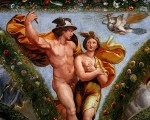The Loggia takes its name from the decoration frescoed on the vault by Raphael and his workshop in 1518. The frescos represent episodes from the fable of Psyche, narrated in Apuleiu’s Golden Ass, which had already been used in the fifteenth century for nuptial imagery.
The loggia was also used as a stage for celebrations and theatrical performances organised by Agostino himself.
To give the space a festive and theatrical feel to it, Raphael also transformed the vault of the Loggia into a pergola, adorned with magnificent hanging festoons, as though the greenery of the gardens had invaded the Villa itself. In the centre he designed two fictive tapestries which depict the concluding scenes: the splendid Council of the Gods, where the unjustly persecuted girl is finally received by the gods with divine complacence, and the Marriage of Cupid and Psyche, the symbolic culmination of the entire cycle.
However, although the general layout of the cycle and planning of the individual scenes and figures are attributed to the intuitive genius of Raphael (proven by a number of autographic sketches), the actual completion of the designs into frescos was carried out by his numerous workshop assistants, including Giovanni Francesco Penni, Giulio Romano and Giovanni da Udine. The latter, in particular, was the creator of the exuberant triumphal festoons.
The exterior walls have a double row of Doric pilasters, surmounted by an entablature with cherubs and festoons.


